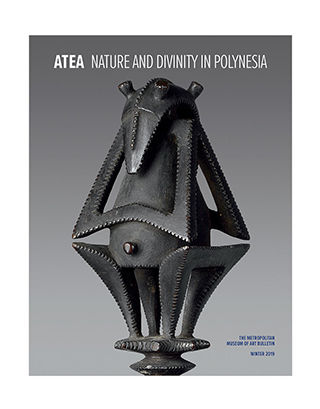
Representing a new phase in scholarship, the winter 2019 Bulletin focuses on some thirty exceptional works of Polynesian art.
Buy NowThis exhibition celebrates the creative ingenuity of Polynesian artists who drew from the natural world to give material expression to their understanding of the divine. Drawn from American collections and The Met's own holdings, the exhibition showcases some thirty works—figural sculpture, painted barkcloth, rare featherwork, and more—dating from the late eighteenth to the nineteenth century. The presentation offers visitors an opportunity to understand a core principle of Pacific art: the divine is not abstract but very much alive in nature.
Atea is a Polynesian cosmological term that refers to the moment when it was believed that light first sparked forth after many eons of thick, engulfing darkness, resulting in the birth of the first generation of gods. Across Polynesia, ritual artifacts were created for the powerful chiefs who descended from these gods and who, as political and religious leaders, were imbued with the spiritual essence (mana) of their forbears. Prestige items such as feather cloaks and headdresses reinforced their status and reputation and asserted genealogical connections with their divine ancestors. These spectacular works illustrate the vitality of the natural world and highlight the ways in which Polynesian elites strategically channeled its material potency to enhance their own spiritual efficacy.
Accompanied by a Bulletin.
"Fascinating" —New Yorker
The Met's quarterly Bulletin program is supported in part by the Lila Acheson Wallace Fund for The Metropolitan Museum of Art, established by the cofounder of Reader's Digest.
What makes this a must-see exhibition? Prepare for your visit with this introduction to the show's themes and artworks.
Presented in the exhibition gallery, this chant invokes two pairs of principal gods (akua) of Hawai'i: first, Ku, who is associated with governance and warfare, and his counterpart Lono, who brings the rains that encourage fertility; and second, Kāne, usually associated with the land, and Kanaloa, who presides over the ocean. Polynesian gods are not easily classifiable and are inherently multiple. The four in this chant derive from earlier deities found in Tahiti and Tonga who are known by similar names: Tu and Rongo, and Tane and Ta'aroa (Tonga: Tangaloa).
Recorded on June 11, 2018, at The Metropolitan Museum of Art, New York, by Samuel M. 'Ohukani'ōhi'a Gon, III, Marques Hanalei Marzan, Anne Lokomaika'i Lipscomb, and Marie Ke'alohilani Wong
Ritual dish (Daveniyaqona), early 19th century. Fiji. Wood, 12 3/4 x 7 3/4 x 2 in. (32.4 x 19.7 x 5.1 cm). The Metropolitan Museum of Art, New York, Purchase, 2017 Benefit Fund, Gordon Sze, MD, The Richman Family Foundation, and Steven Kossak Gifts, Andrea Bollt Bequest, in memory of Robert Bollt Sr. and Robert Bollt Jr., and Ruddock Foundation for the Arts Gift, 2018 (2018.433)